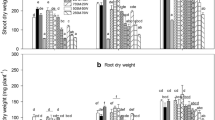Abstract
The aim of the present investigation was to determine how the chemical composition of L. multiflorum (var. Imperial) shoots influences the initial dynamic decomposition phase. Decomposition in soil was monitored by taking semicontinuous respiration measurements with a resolution of 1 h. Shoots with six different total N contents(2.0–5.2%) were compared. The carbohydrate content of the shoots decreased with increasing total N content, whereas the free amino acid and protein contents increased. Two respiration peaks were observed during the 1-week-long incubation. Comparisons of C mineralisation curves for water-extracted and whole shoots showed that the first peak was derived from water-soluble plant components. Lengths of lag phases and values of specific microbial growth rates obtained from respiration curves of sugars and amino acids implied that these substances were mineralised during the time of the first respiration peak. Amounts of CO2-C evolved from the shoots during the first peak increased linearly as a function of the sum of the content of glucose, fructose, sucrose, fructans, and free amino acids in the shoots. The shoots with two highest N contents showed net N mineralisation during the first respiration peak, whereas at a lower N content there was net immobilisation. It was concluded that soluble carbohydrates and free amino acids were important C and energy sources for the decomposers during the time encompassed by the first respiration peak. The second peak was derived from both water-soluble and water-insoluble plant components, and the amount of C respired increased with an increasing protein content.
Similar content being viewed by others
References
Chapman SB (1971) A simple conductometric respirometer for field use. Oikos 22:348–353
Cochran VL, Horton KA, Cole CV (1988) An estimation of microbial death rate and limitations of N or C during wheat straw decomposition. Soil Biol Biochem 20:293–298
Cogle AL, Saffigna PG, Strong WM (1989) Carbon transformations during wheat straw decomposition. Soil Biol Biochem 21:367–372
Collins HP, Elliott LF, Papendick RL (1990) Wheat straw decomposition and changes in decomposability during field exposure. Soil Sci Soc Am J 54:1013–1016
Goswami AK, Willcox JS (1969) Affect of applying increasing levels of nitrogen to ryegrass. I. Composition of various nitrogenous fractions and free amino acids. J Sci Food Agric 20: 592–595
Harder W, Dijkhuizen L (1982) Strategies for mixed substrate utilization in microorganisms. Phil Trans R Soc Lond B 297: 459–480
Hegarty MP, Peterson PJ (1973) Free amino acids, bound amino acids, amines and ureids. In: Butler GW, Bailey RW (eds) Chemistry and biochemistry of herbage, vol 1. Academic Press, London, pp 1–62
Jansson SL (1958) Tracer studies on nitrogen transformations in soil with special attention to mineralisation and immobilisation relationships. K Lanbrukshoegsk Ann 24:101–361
Lyttleton JW (1973) Proteins and nucleic acids. In: Butler GW, Bailey RW (eds) Chemistry and biochemistry of herbage, vol 1. Academic Press, London, pp 63–103
Marstorp H, Kirchmann H (1991) Carbon and nitrogen mineralization and crop uptake of nitrogen from six green manure legumes decomposing in soil. Acta Agric Scand 41:243–252
Nordgren A (1988) Apparatus for the continuous, long-term monitoring of soil respiration rate in large number of samples. Soil Biol Biochem 20:955–957
Nordgren A, Bååth E, Söderström B (1988) Evaluation of soil respiration characteristics to assess heavy metal effects on soil microorganisms using glutamic acid as a substrate. Soil Biol Biochem 20:949–954
Nowakowski TZ (1962) Effects of nitrogen fertilizers on total nitrogen, soluble nitrogen and soluble carbohydrate contents of grass. J Agric Sci 59:387–392
Pirt JS (1975) Principles of microbe and cell cultivation. Blackwell Scientific Publications, Oxford
Reber H (1974) Regulation of amino acid and glucose dissimilation in so-called ammonifiers and in other soil microorganisms. Arch Microbiol 101:247–258
Reinertsen SA, Elliott LF, Cochran VL, Campbell GS (1984) Role of available carbon and nitrogen in determining the rate of wheat straw decomposition. Soil Biol Biochem 16:459–464
Smith D (1972) Carbohydrate reserves of grasses. In: Younger VB, McKell CM (eds) The biology and utilization of grasses. Academic Press, New York, pp 318–331
Smith D (1973) The nonstructural carbohydrates. In: Butler GW, Bailey RW (eds) Chemistry and biochemistry of herbage, vol. 1. Academic Press, London, pp 105–155
Steen E, Larsson K (1986) Carbohydrates in roots and rhizomes of perennial grasses. New Phytol 104:339–346
Stenström J, Hansen A, Svensson B (1991) Kinetics of microbial growth-associated product formation. Swed J Agric Res 21: 55–62
Author information
Authors and Affiliations
Rights and permissions
About this article
Cite this article
Marstorp, H. Influence of soluble carbohydrates, free amino acids, and protein content on the decomposition of Lolium multiflorum shoots. Biol Fert Soils 21, 257–263 (1996). https://doi.org/10.1007/BF00334901
Received:
Issue Date:
DOI: https://doi.org/10.1007/BF00334901




